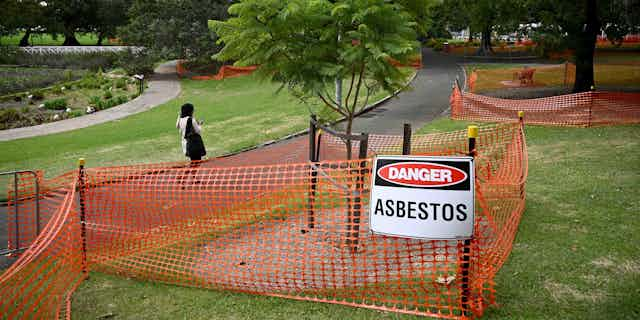This week, disturbing news emerged about mulch containing asbestos in parks, schools and homes across New South Wales (and possibly Canberra). So far, the discussion has focused on the risks to human health.
But the incidents have prompted me to worry about the effects on dogs. Dogs love to sniff, dig, lick and roll on the ground. That means dogs in the vicinity of the mulch may have been exposed to asbestos.
I research the environmental causes of cancer in animals. Animal exposure to asbestos is deeply worrying. Long-term exposure, even to low doses, can cause a type of cancer called mesothelioma. The disease also affects humans.
Here, I outline the risks of asbestos exposure in dogs, and what to do if you’re concerned.
Read more: Asbestos in mulch? Here's the risk if you've been exposed
What do we know about mesothelioma in dogs?
Mesothelioma is an aggressive cancer that affects both animals and humans. It’s typically concentrated in the respiratory tract, but can affect all cells lining body cavities.
The illness is rare in dogs, causing less than 1% of all canine tumours. But it takes years to develop, by which time successful treatment is difficult.
Symptoms in dogs include difficulty breathing, enlarged abdomen and muffled heartbeat. A dog may cough, become lethargic, lose its appetite and become depressed.
In dogs, the incubation time – the period when the cancer is developing, is less than eight years, compared with more than 20 years in humans. So studying cancer in pet dogs can provide important information about similar cancers that might also affect humans.
Dogs can be exposed to asbestos in the same way as humans – for example, during home renovation projects. People can wear protective gear, but animals cannot. Dogs also tend to lick things, which means they may ingest asbestos fibres as well as breathe them in.
Asbestos is more dangerous when it is “friable” or easily crumbled and broken up into smaller pieces, releasing fibres into the air.
One study from the 1980s showed dogs could be exposed to asbestos, through “secondary contact” or the actions of someone else. This may occur, for example, if a dog inhaled asbestos fibres from the clothes of its owner.
So during house renovations, pets may need to stay mostly outside, or at someone else’s house or a boarding kennel.

What about the mulch issue?
At latest count, 47 sites in NSW have tested positive for asbestos in mulch. In the Australian Capital Territory, environment officials are investigating potentially contaminated “cottage mulch” sold to 24 companies and 27 addresses in and around Canberra.
In all but one Sydney case, the asbestos was considered lower-risk as it was mixed with cement or other hard bonding materials. However, “non-friable” or “bonded” asbestos can become friable if damaged or old. Then, asbestos can be released into the air.
The more dangerous friable asbestos was found at a popular public park in Glebe. This is concerning.
The risk of an animal developing cancer is influenced by duration of exposure and the extent of contamination. We don’t know what level of exposure is required to develop mesothelioma in dogs. But in humans, there is no known safe asbestos exposure level.
What to do if you’re concerned
Mesothelioma can progress rapidly in both dogs and humans. Early diagnosis increases the chance of survival.
If you think your dog has been exposed to asbestos, take it to see a vet. The vet may perform an x-ray to check the dog’s lungs and/or abdomen and windpipe. If damage is present, a vet would take samples of tissue and fluids from the thorax or abdomen, for further examination.
So what happens if a dog is diagnosed with mesothelioma?
In some cases, the cancer will be so far progressed that treatment is not an option. In that case, all effort should be made to ensure the dog is as comfortable as possible.
If it’s not too late to start treatment, dogs can undergo chemotherapy, usually in the form of injections. One study suggests chemotherapy increases a dog’s chance of survival.
The duration of treatment and side effects of chemotherapy vary depending on the severity of the dog’s case. Deciding whether or not to proceed with chemotherapy can be difficult and requires weighing up the costs and likely benefits. It is expensive, but many dogs cope remarkably well and rarely lose their hair.
A wake-up call
Cancer in pets doesn’t always develop by chance. It can be caused by the air they breathe, the soil they dig in and the water they drink.
The case of asbestos-contaminated mulch should be a wake-up call for regulators and industry. But it should also remind pet owners to carefully consider the substances their animals might be exposed to, both inside and outside the home.
Gathering data on canine exposure to environmental hazards is crucial to understanding the origin of spontaneous cancers. We have just launched a national survey on the topic. You can find it here.
Read more: Why does my dog eat grass? And when is it not safe for them?

